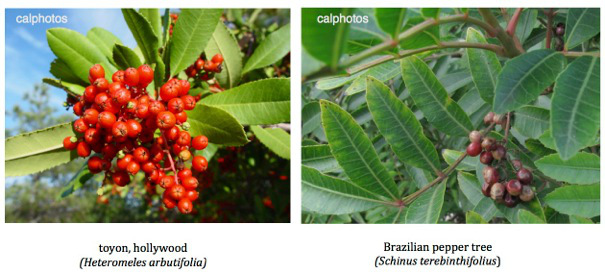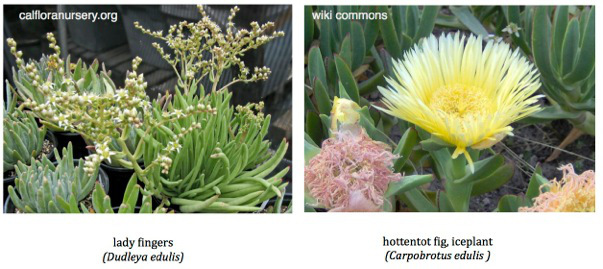People may say that “all the pretty plants” in Southern California are from somewhere else – that San Diego is a desert and beautiful because we water it. It’s not true. There are lots of beautiful, water-friendly native plants, and by planting them in your yard you can help preserve and protect our open spaces. California Sea Grant’s Theresa Talley, a coastal specialist at UC San Diego, lists some native alternatives to common “bad” plants, explains their ecological benefits, and tells us where we can buy them.
I’ve been interviewed about invasive species a few times recently by grade and high school students, and it struck me that the topic might be of use to a broader audience, especially those who might be thinking of doing a little planting as we head into summer. Here are some of the questions I’ve received and my answers:
What is an invasive species? When people say “invasive,” they are usually talking about two different ideas — introduced and invasive. An introduced species is one brought into an area outside its natural range. This does happen in nature – for example, birds can be blown across narrow ocean passages during large storms – but, it’s rare. Usually, introductions happen because people move species from place to place, either intentionally or accidentally. An introduced species isn’t a bad thing, per se. Most of the crops grown in the United States are not originally from North America, and we value and depend on these plants. The problem is when a species is invasive. An invasive species is one that can spread from its introduction site, take over new territory and displace native species. Figures 1-3 (below) show common horticultural plants that are invasive in Southern California and natives that look similar but are not invasive.

Figure 1. Both the native toyon shrub (left) and the introduced invasive Brazilian pepper tree (right) have showy red berries. Toyon has thick evergreen leaves that make it drought tolerant. The pepper tree uses chemical warfare to suppress the growth of plants beneath it and sends out suckers that can span several backyards.
How do we know if a plant is invasive? If a plant has become invasive elsewhere, even in its home habitat, it’s more likely to be invasive in your area, too. For plants with unknown track records, fast growth rates, high reproductive rates, and being a generalist (not picky about habitat) are all red flags of potential trouble. Other red flags include: having wide physiological tolerances (to extremes in temperatures, for example), having no predators or diseases in the new area, having the ability to use untapped resources, or a novel ability to obtain shared resources. Some plants are ecosystem engineers, which means they can influence and re-engineer their physical and chemical environments. These plants are also candidates for being invasive. Plants sold for landscaping are yet other candidates, as they have been pre-selected for their ability to thrive in replanted areas. Ice plant (figure 2, below), for example, was introduced to California from another semi-arid, coastal climate, South Africa, and so often “escapes” from planted areas, invading our canyons and coastal bluffs. Ice plant can grow over existing plants and get so heavy with growth that it, and the bank on which it is growing, may come tumbling down. This can exacerbate erosion and open the door to other invaders.

Figure 2. Lady fingers (left) and chalk liveforever, Dudleya pulverulenta (not shown), are drought-tolerant, fire-resistant alternatives to the highly invasive, roadside-familiar ice plant (right).
What is the worst invasive species? No one species is the worst in every place. The threat depends on factors such as location, environmental conditions and other species present. In general, invasive species that pose the greatest threat are (1) those with traits that are novel or new to an area or (2) those that alter the surrounding physical or chemical environment. Species with novel traits can often edge-out native species because they may be able to tap pools of resources that other species cannot. The kudzu invasion of the southeastern United States is an example of a highly invasive plant with these characteristics. Before kudzu was introduced, there were no other (or not many) fast-growing, woody, nitrogen-fixing vines in the region. So, it was able to overgrow trees, shrubs and smaller vines, and even increase the availability of soil nitrogen to favor itself and disfavor natives adapted to lower nitrogen levels. Crown daisy (figure 3, below) is an example of an invasive plant in Southern California with these characteristics. This large annual plant quickly grows in disturbed or open areas within coastal sage scrub ecosystems, dominated by slower-growing perennial shrubs. It is able to germinate and grow with the first rains of the season, outcompeting natives for light and other resources and potentially producing growth-inhibiting chemicals that further inhibit natives.

Figure 3. The native perennial daisy (left) and the invasive, introduced annual daisy (right). While the native perennial provides habitat all year, the annual daisy dies by early summer, leaving little habitat behind and increasing fire hazard.
Should we not use invasive plants in our yards? We don’t necessarily need to stop planting introduced plant species. However, we should not plant species that are known to be invasive. The problem is that we don’t usually know if, or when, an introduced species will become invasive, and spread to our neighbors’ yards and our open spaces. For this reason, we should be extra careful about what we choose to put in our yards and try to stick with natives (which should do well since they are from the area!). Natives have the added benefit of providing native habitat and encouraging native wildlife and insects.
Where can we get native plants? Getting native plants that originated from an area as close to your yard as possible is the best strategy since the plants will be best adapted to your microclimate. Please don’t, however, take plants from our natural areas. These plants serve valuable functions as wildlife habitat, erosion control, weed control, and runoff filters; and, they are there for all of us to enjoy.
Written by Theresa Talley and Christina Johnson